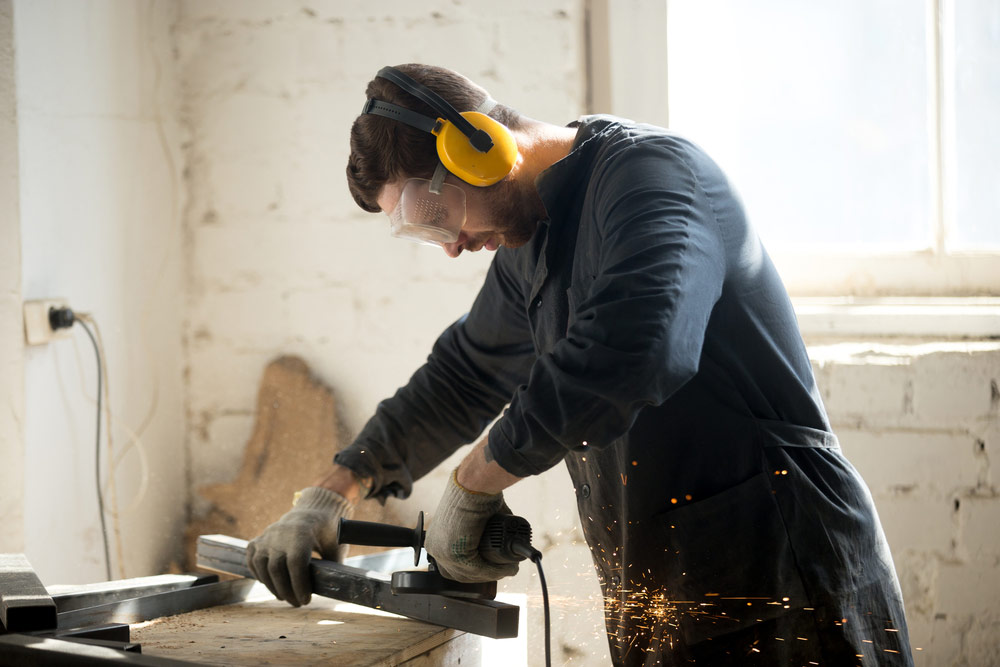Loud workplaces are more common than you think, and while putting in your earplugs or remembering your earmuffs might seem small, they can make a big difference for your quality of life down the road. Without proper ear protection, personnel exposed to loud work environments face noise-induced hearing loss (NIHL). Let’s take a look at what NIHL is, what your life could look like with NIHL, and how to prevent noise-induced hearing loss in the first place.
What is Noise-Induced Hearing Loss?
Noise-induced hearing loss is a condition most often defined by a loss of hearing due to extended exposure to loud sound, but it can also be caused by a one-time loud sound or blast of excessive noise. Generally, noise-induced hearing loss results from damage to structures or nerve fibers in the inner ear that respond to sound.
There are two types of noise-induced hearing loss — temporary threshold shift (TTS), and permanent threshold shift (PTS).
Temporary Threshold Shift (TTS)
TTS is, as its name suggests, a temporary loss of hearing, usually at higher frequencies. In the workplace, TTS might occur if you’re standing by a loud machine without hearing protection for a short period of time. Outside of the workplace, if you’ve ever gone to a loud concert and left feeling like the rest of the world sounded very quiet, or with a ringing in your ears, you’ve probably experienced TTS.
TTS is often accompanied by that ringing or head noise, which is called tinnitus. Typically, you can expect to recover from the TTS type of noise-induced hearing loss in a few hours to a few days.
Permanent Threshold Shift (PTS)
PTS is a nervous system disorder that happens over time and cannot be noticed until it’s too late. PTS is the result of nerve or hair cell destruction in the inner ear, most often caused by extended exposure to noises over 85 decibels.
In the workplace, PTS can occur in employees who operate heavy, loud machinery without hearing protection, and in employees who work in loud construction or manufacturing environments without hearing protection. PTS is not reversible.
It’s important to know that both types of noise-induced hearing loss — PTS and TTS, are preventable. Because PTS is not reversible, it is important to take safety precautions whenever possible, and wear the proper hearing protection for the noise levels present both at work and in your life outside of work.
How Can Noise-Induced Hearing Loss Impact Your Life?
While noise-induced hearing loss is preventable, unfortunately too many people forgo hearing protection because they just don’t understand the risks to their safety and their quality of life. Let’s take a look at how NIHL can affect your life at increasing levels of severity.
Mild Noise-Induced Hearing Loss
When NIHL causes mild hearing loss, you’ll have difficulty hearing softer and more subtle sounds. Professionals say that mild hearing loss is a comparable feeling to sticking a finger in the ear of someone with typical hearing. Sounds you might miss out on with mild hearing loss due to NIHL include:
- Some softer consonant sounds
- Soft-spoken people and young children
- Subtle sounds like birds chirping or leaves rustling outdoors.
With mild noise-induced hearing loss, you may have to ask people to speak up or repeat themselves.
Moderate Noise-Induced Hearing Loss
Moderate noise-induced hearing loss is often described as being able to hear, without always being able to understand. If NIHL progresses to moderate, here are some of the sounds you could miss out on:
- Vowel sounds, which makes it difficult to understand what people are saying
- Normal conversation levels. You will have to ask people to speak up around you
- Louder sounds like a baby crying or a dog barking
Severe Noise-Induced Hearing Loss
Severe hearing loss is an unfortunate, but common result of extended exposure to noises over 85 decibels. With severe hearing loss, speech is inaudible without support from hearing aids. A person with severe hearing loss is unable to hear most common noises, like a neighbor’s lawnmower, and even very loud sounds like traffic and fire alarms may be inaudible.
The prospect of severe noise-induced hearing loss can be frightening, but it’s important to remember that noise-induced hearing loss at any level is preventable.
How Can You Prevent Noise-Induced Hearing Loss?
The best way to prevent noise-induced hearing loss is to avoid or limit your exposure to excessively loud sounds. This might include:
- Turning down the volume of television, music, podcasts, etc. so they are audible, but not blasting
- Moving away from the source of loud sounds when possible
If you work in a loud environment and are unable to avoid excessively loud sounds, the appropriate hearing protection can help to prevent noise-induced hearing loss. It’s important to choose earplugs and earmuffs that are rated for the level of noise present in your unique workplace situation.
Noise-induced hearing loss is preventable. With proper hearing protection and education, your workplace can help to prevent NIHL in all employees exposed to loud conditions. For more information about NIHL prevention and safety tips, we encourage you to look into eSafety’s course on Hearing Conservation. And for a safety training system your team can use to reach every employee, learn how eSafety’s course library can fit into your workplace.

